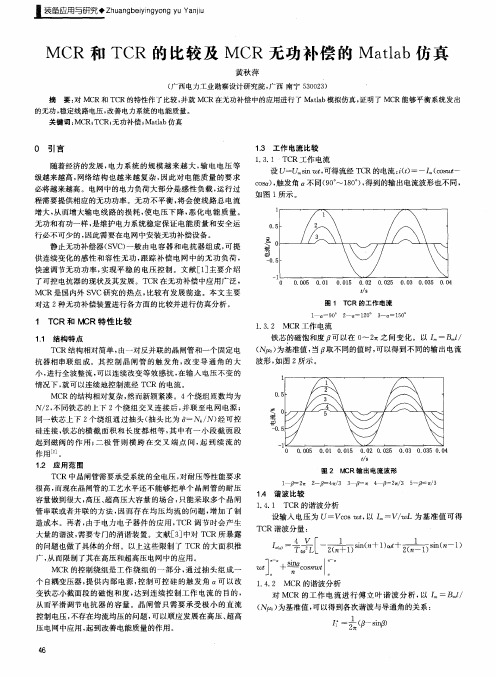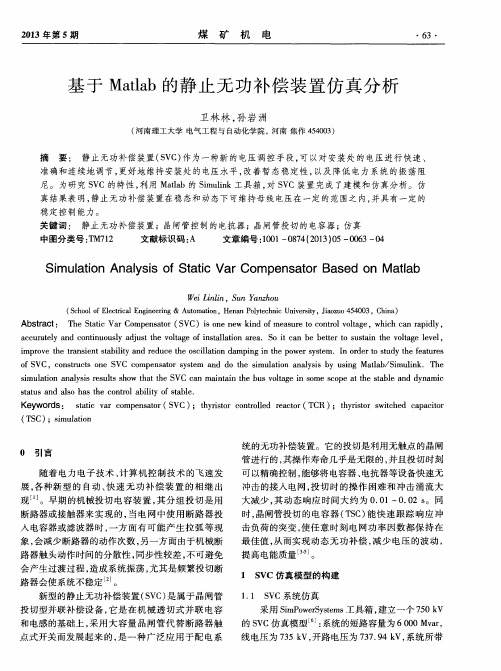最新MATLAB的无功补偿
- 格式:ppt
- 大小:1.13 MB
- 文档页数:2





基于MATLAB的500kV变电站无功补偿仿真研究作者:付凯岳学彬来源:《科学与财富》2016年第25期摘要:通过对SVC技术的原理分析研究,利用Simulink构建了SVC装置的仿真模型,并验证了该模型对500kV变电站有很好的无功补偿效果。
仿真结果表明,SVC装置可快速调节其发出的无功,对电站动态无功补偿,调节系统电压,提高系统电压的稳定水平。
关键词:SVC;无功补偿;500kV;TCR1 引言随着电力电子技术的发展,大量的电力电子非线性负载接入电网,降低了电网的电能质量,SVC无功补偿装置具有吸收和发出无功,调节电力系统电压,提高系统的功率因数,从而提高电力系统的电能质量。
SVC技术是灵活交流输电(FACTS)技术之一。
2 TCR型的SVC装置的结构及原理2.1 TCR型的SVC装置的结构由于大功率电力电子器件制造技术的发展,SVC从早期的SSR过渡到TCR/TSC方式,并成为SVC的主流实用技术。
国外TCR/TSC型的SVC装置从上世纪70年代投入商业运行以来,其装置集成技术、控制原理、设备制造技术已趋于成熟,是目前仍广泛使用的动态无功补偿设备[2]。
根据结构原理的不同,SVC技术又分为:自饱和电抗器型(SSR-Self-saturable Reactor)、晶闸管相控电抗器型(TCR -Thyristor Controlled Reactor)、晶闸管投切电容器型(TSC–Thyristor Switched Capcitor)、高阻抗变压器型(TCT)和励磁控制的电抗器型(AR)等[1]。
我国目前在TCR的SVC装置技术方面也趋于成熟,但是在更高电压等级变电站用超大容量SVC应用技术还有待研究[3,4]。
本文主要就是通过MATLAB仿真来研究500kV变电站用超大容量TCR型SVC装置来调节系统的无功,稳定系统的电压,从而达到提高电能质量的目的。
TCR型SVC装置主要由滤波、电容支路和TCR支路组成,其结构和接线如图1所示。

基于MATLAB电力系统无功补偿器的研究摘要:随着电力电子设备、交直流电弧炉和电气化铁道等非线性、冲击性负荷的大量接入电网,引起了电网无功功率不足、电压波动与闪变、三相供电不平衡以及电压电流波形畸变等其它一系列电能质量问题,并严重威胁着电力系统的安全稳定运行。
首先,本文介绍了无功功率的基本概念,介绍了无功功率对电力系统的影响以及无功补偿的作用。
并详尽的阐述了国内外无功补偿装置的历史以及现状。
其次,本文详细分析了静止无功补偿器(SVC)和静止无功发生器(SVG)的基本结构,控制方法和工作原理,以及各自优特点。
并且阐述了它们的工作特性。
再次,本文着重进行了对SVG型静止无功补偿器提高系统电压的理论研究。
利用MATLAB/SIMULINK仿真软件对SVG工作方式及利用SVG 动态提高系统电压的原理进行仿真研究。
并对仿真结果进行了全面分析。
最后,本文完成了一种无功补偿控制器的设计,该控制器在系统硬件上采用了由STC生产的STC10F08X单片机作为主控制器。
采用ATT7022作为电能检测芯片,实现电网参数的精确采样与计算。
在系统软件上采用晶闸管控制投切电容器,实现了电容器的快速,无弧的投切。
采用全中文液晶显示界面实时显示系统运行状况。
关键字:无功补偿,SVG,SVC,STC10F08XABSTRACTWith the power electronics equipment, AC and DC electric arc furnace and electric railways, and other non-linear, the impact of a large number of load connected to the grid, causing a power shortage of reactive power, voltage fluctuation and flicker, three-phase voltage and current power imbalances, and a series of waveform distortion and other power quality problems and a serious threat to security and stability of power systems.First, this paper introduces the basic concepts of reactive power, reactive power described the impact on the power system and the role of reactive power compensation. and a detailed exposition of the international history of reactive power compensation device and the status quo.Secondly, a detailed analysis of SVG and SVC basic structure, control methods and work principles, as well as the advantages and features of SVG. And describes the work of SVG features.Again, this paper focuses on SVG for Static Var Compensator improve the system voltage theory. Operations through the derivation of the formula to explain how to stabilize the system voltage . we use MATLAB/SIMULINK simulation software works and the use of SVG dynamic principle improve the system voltage simulation. And a comprehensive analysis of the simulation results.Finally,This paper completed a reactive power compensation controller hardware design .The controller on the system hardware used by the STC production STC1OF08X micro controller as master controller. As ATT7022 a power test chip, accurate sampling and calculation of the implementation of network parameters. The thyristor controlled switched capacitor, capacitor, no arc switching on the system software. The Chinese LCD interface real-time display system operating conditions.Keywords:Reactive compensation ;SVG ;SVC;STC10F08X第1章绪论1.1 课题背景随着现代电力电子技术的飞速发展,大量大功率、非线性负荷的接入电网中,使得电网供电质量受到了严重的威胁。
基于MATLAB的TCR-TSC型无功补偿装置(SVC)仿真研
究
孙楷淇
【期刊名称】《安徽电气工程职业技术学院学报》
【年(卷),期】2011(016)B10
【摘要】本文阐述了一种TCR-TSC型无功补偿装置(SVC)设计,对系统级模型进行理论分析,利用了交流无触点开关系统与矢量控制系统,采用MATLAB对模拟系统进行了仿真,仿真结果表明了该设计方法的正确性和有效性。
【总页数】5页(P1-5)
【作者】孙楷淇
【作者单位】阜阳市供电公司,安徽阜阳236017
【正文语种】中文
【中图分类】TM761.12
【相关文献】
1.新一代智能型低压无功补偿装置为配网系统带来的变革——基于FST系列智能型积木式低压无功补偿装置的应用及效果分析 [J], 贾成荣
2.基于Matlab的静止无功补偿装置仿真分析 [J], 卫林林;孙岩洲
3.基于MATLAB的无功补偿装置的研究与仿真 [J], 王玥;赵茂胜
4.基于MATLAB的TCR-TSC型无功补偿装置(SVC)仿真研究 [J], 孙楷淇
5.基于瞬时无功功率理论的SVC系统研究与Matlab仿真 [J], 郑祎群
因版权原因,仅展示原文概要,查看原文内容请购买。
安徽工业大学 毕业设计(论文)说明书第- 1 -页┊ ┊ ┊ ┊ ┊┊ ┊ ┊ ┊ ┊ 装 ┊ ┊ ┊ ┊ ┊ 订 ┊ ┊ ┊ ┊ ┊ 线 ┊ ┊ ┊ ┊ ┊ ┊ ┊ ┊ ┊ ┊ ┊ ┊┊ ┊ ┊ ┊ ┊ ┊ ┊ ┊ ┊ ┊ ┊ 装 ┊ ┊ ┊ ┊ ┊ 订 ┊ ┊ ┊ ┊ ┊ 线 ┊ ┊ ┊ ┊ ┊ ┊ ┊ ┊ ┊ ┊ ┊ ┊ ┊ ┊ ┊ ┊ ┊摘 要本文主要介绍MATLAB 在静止无功补偿设计中的应用。
总结了几种常见的无功补偿装置,并比较了其优点及缺点。
研究了静止无功补偿器(SVC)在提高电网电压稳定性中的应用,对静止无功补偿器SVC 的功能进行了说明。
阐述了各种静止无功补偿技术的原理、优点、缺点以及其在电力系统中的应用情况。
阐述了一种TCR-TSC 型无功补偿装置(SVC)设计,对系统级模型进行理论分析,采用MATLAB 对模拟系统进行了仿真。
仿真结果表明加入SVC 装置的系统可以有效改善电网系统电压变化,能显著改善电网系统中电压质量。
关键词:静止无功补偿装置,功率因数,MATLAB 仿真第- 2 -页┊ ┊ ┊ ┊ ┊ ┊ ┊ ┊ ┊ ┊ 装 ┊ ┊ ┊ ┊ ┊ 订 ┊ ┊ ┊ ┊ ┊ 线 ┊ ┊ ┊ ┊ ┊ ┊ ┊ ┊ ┊ ┊ ┊ ┊ ┊ ┊ ┊ ┊ ┊ ┊ABSTRACTThis paper describes the MATLAB application in the design of Static Var Compensator.It summarizes several common reactive power compensation,their strengths and weaknesses are compared.The application of static var compensator to improve voltage stability of power grid was studied. The function of static var compensator(SVC) was explained .The principle,advantageous and drawback of various static var compensator and there application in the electric system were expounded.A TCR-TSC static var compensator (SVC) is designed in this paper.It is theoretically Analysis the SVC system-level model. Then the model system is simulated by using MATLAB.The simulation results show that the SVC device can effectively improve the power system voltage changes can significantly improve the voltage quality in the grid system.Keywords :Static Var Compensator(SVC),Power factor ,MATLAB Simulation安徽工业大学 毕业设计(论文)说明书第- 3 -页┊ ┊ ┊ ┊ ┊ ┊ ┊ ┊ ┊ ┊ 装 ┊ ┊ ┊ ┊ ┊ 订 ┊ ┊ ┊ ┊ ┊ 线 ┊ ┊ ┊ ┊ ┊ ┊ ┊ ┊ ┊ ┊ ┊ ┊┊ ┊ ┊ ┊ ┊ ┊ ┊ ┊ ┊ ┊ ┊ 装 ┊ ┊ ┊ ┊ ┊ 订 ┊ ┊ ┊ ┊ ┊ 线 ┊ ┊ ┊ ┊ ┊ ┊ ┊ ┊ ┊ ┊ ┊ ┊ ┊ ┊ ┊ ┊ ┊目录1. 引言 (5)1.1课题背景.................................................................................................. 5 1.2国内外研究现状和研究意义.................................................................. 6 1.3论文工作介绍.......................................................................................... 9 2. 无功功率及无功补偿概述.. (10)2.1 无功功率............................................................................................... 10 2.2无功补偿的意义与作用........................................................................ 12 2.2.1无功补偿概述............................................................................. 12 2.2.2无功补偿的意义与作用............................................................. 12 2.3无功补偿基本事项.. (14)2.3.1 无功补偿的原则........................................................................ 14 2.3.2无功补偿的方式......................................................................... 14 2.3.4 配电网无功补偿存在的问题.................................................... 15 2.4无功补偿发展历程................................................................................ 16 3. 静止无功功率补偿器. (19)3.1概述........................................................................................................ 19 3.2 SVC 分类 ............................................................................................... 20 3.3 SVC 动态补偿原理 ............................................................................... 20 3.4 晶闸管相控电抗器(TCR ) (21)3.4.1 TCR 结构 .................................................................................... 22 3.4.2 TCR 的运行特性 ........................................................................ 23 3.5晶闸管投切电容器(TSC ) . (24)3.5.1 TSC 的结构 ................................................................................ 24 3.5.2TSC 的运行特性 . (25)4. MATLAB 仿真 (26)4.1 MATLAB 概述 ...................................................................................... 26 4.2仿真的必要性和优越性........................................................................ 28 4.3基于TCR 和TSC 仿真模型 . (29)4.3.1晶闸管控制电抗器仿真图......................................................... 30 4.3.2晶闸管投切电容器仿真图......................................................... 31 4.3.3 SVC 控制系统 ............................................................................ 32 4.4仿真分析及结论.................................................................................... 34 总结与展望.......................................................................................................... 36 致谢. (38)第- 4 -页┊ ┊ ┊ ┊ ┊ ┊ ┊ ┊ ┊ ┊ 装 ┊ ┊ ┊ ┊ ┊ 订 ┊ ┊ ┊ ┊ ┊ 线 ┊ ┊ ┊ ┊ ┊ ┊ ┊ ┊ ┊ ┊ ┊ ┊ ┊ ┊ ┊ ┊ ┊ ┊参考文献 (39)安徽工业大学 毕业设计(论文)说明书第- 5 -页┊ ┊┊┊ ┊ ┊ ┊ ┊ ┊ ┊ 装 ┊ ┊ ┊ ┊ ┊ 订 ┊ ┊ ┊ ┊ ┊ 线 ┊ ┊ ┊ ┊ ┊ ┊ ┊ ┊ ┊ ┊ ┊ ┊┊ ┊ ┊ ┊ ┊ ┊ ┊ ┊ ┊ ┊ ┊ 装┊┊ ┊┊ ┊订┊┊┊┊┊线┊ ┊ ┊ ┊┊ ┊ ┊┊┊ ┊┊ ┊┊┊┊┊ ┊ 1. 引言1.1课题背景在电力系统中,供电的质量、电网运行的安全可靠性和经济性是最根本的问题。